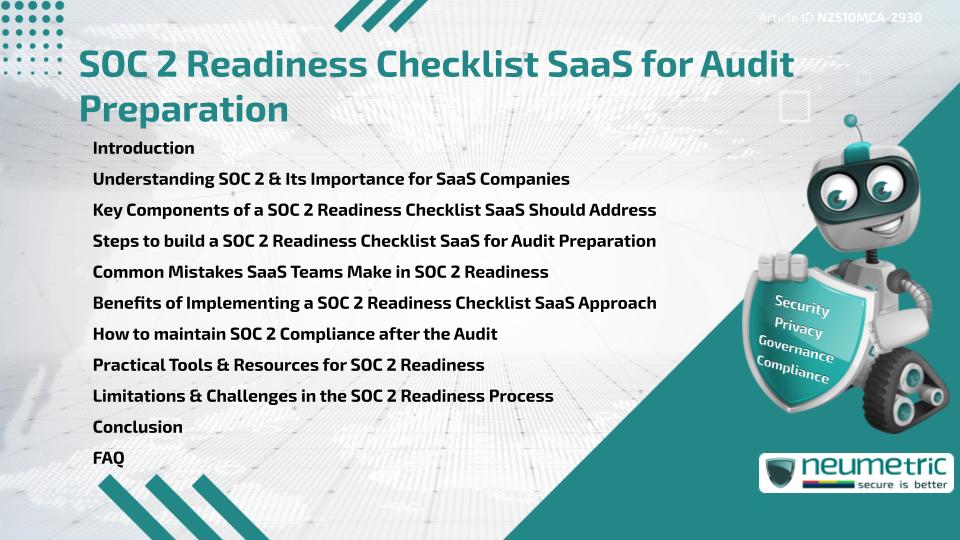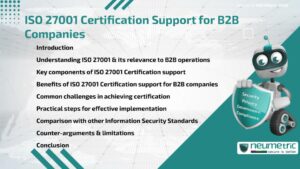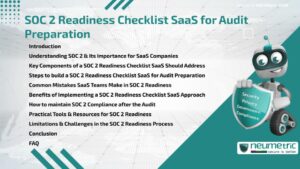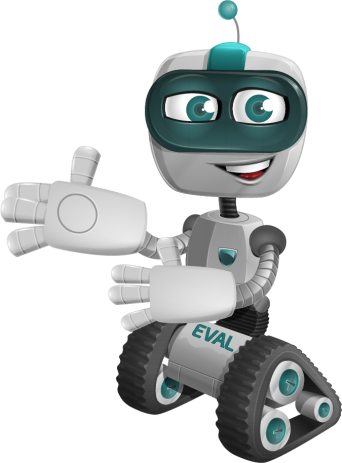Table of Contents
ToggleIntroduction
Preparing for a SOC 2 Audit can be overwhelming for Software-as-a-Service [SaaS] providers. The SOC 2 readiness checklist SaaS Framework simplifies this process by offering a structured Roadmap to ensure all Compliance Requirements are met before the official Audit. This checklist focuses on five (5) Trust Service Criteria: security, availability, processing integrity, confidentiality & Privacy. It enables SaaS Organisations to evaluate existing controls, identify gaps & align practices with auditor expectations.
A well-defined SOC 2 readiness checklist SaaS approach not only accelerates Audit preparation but also reduces Risk exposure & improves Data Management practices. This Article explores key components, practical steps, common mistakes & post-Audit strategies that help SaaS teams succeed in achieving & maintaining SOC 2 compliance.
Understanding SOC 2 & Its Importance for SaaS Companies
SOC 2, developed by the American Institute of Certified Public Accountants [AICPA], is a compliance Standard for service Organisations that manage Customer Data. It ensures that systems are designed to safeguard Sensitive Information. For SaaS companies, SOC 2 compliance builds Customer Trust by demonstrating a commitment to security & operational transparency.
Many clients now require vendors to provide a SOC 2 Report before entering into business relationships. Therefore, following a SOC 2 readiness checklist SaaS ensures the company meets regulatory expectations & competitive market demands.
Key Components of a SOC 2 Readiness Checklist SaaS Should Address
A comprehensive SOC 2 readiness checklist SaaS Framework includes several critical components:
- Risk Assessment – Identify Potential Threats to information systems.
- Security Controls – Review access management, encryption & Incident Response.
- Policies & Procedures – Ensure that documentation is up to date & aligns with SOC 2 criteria.
- Vendor Management – Evaluate Third Party Risks related to data handling.
- System Monitoring & Logging – Track activities & detect anomalies.
Each element should be reviewed regularly to maintain ongoing compliance readiness.
Steps to build a SOC 2 Readiness Checklist SaaS for Audit Preparation
Building a SOC 2 readiness checklist SaaS begins with understanding existing processes & identifying compliance gaps. Follow these steps:
- Define the Audit Scope – Determine which systems & processes fall under review.
- Perform a Gap Analysis – Compare current controls against SOC 2 requirements.
- Assign Responsibilities – Involve cross-functional teams such as engineering, operations & legal.
- Implement Corrective Measures – Strengthen weak controls & document changes.
- Conduct an Internal Audit – Use the readiness checklist as a pre-Assessment tool.
These steps create a strong foundation for a smooth & efficient External Audit process.
Common Mistakes SaaS Teams Make in SOC 2 Readiness
SaaS teams often underestimate the time & resources required for SOC 2 preparation. Common mistakes include:
- Relying on incomplete documentation
- Ignoring ongoing Risk Assessments
- Overlooking Vendor dependencies
- Failing to communicate compliance updates company-wide
Avoiding these pitfalls ensures that the SOC 2 readiness checklist SaaS Framework remains robust & Audit-ready.
Benefits of Implementing a SOC 2 Readiness Checklist SaaS Approach
Using a SOC 2 readiness checklist SaaS provides several benefits:
- Operational Efficiency: Streamlined compliance tasks & reduced manual effort.
- Enhanced Data Security: Stronger controls across all systems.
- Customer Assurance: Demonstrates credibility to clients & Stakeholders.
- Audit Readiness: Simplifies auditor interactions & Evidence collection.
By standardizing compliance procedures, SaaS Organisations can focus more on innovation & less on reactive Audit preparations.
How to maintain SOC 2 Compliance after the Audit
Achieving SOC 2 compliance is only part of the journey. Maintaining it requires Continuous Monitoring & Improvement. Regular internal reviews, Employee Training & periodic policy updates ensure that controls remain effective over time.
Additionally, integrating compliance automation tools helps track performance metrics & detect deviations from the SOC 2 Framework.
Practical Tools & Resources for SOC 2 Readiness
Numerous tools can support a SOC 2 readiness checklist SaaS approach, including:
- Automated Compliance Platforms: Tools like Drata or Vanta streamline documentation & monitoring.
- Policy Management Systems: Maintain & update Governance documents efficiently.
- Risk Tracking Software: Identify & prioritise emerging Risks.
These tools help SaaS teams save time while improving the accuracy of compliance reporting.
Limitations & Challenges in the SOC 2 Readiness Process
Despite its effectiveness, the SOC 2 readiness process can face challenges such as limited resources, evolving regulations & inconsistent documentation Standards. Additionally, smaller SaaS Organisations may struggle with cost & staff constraints.
However, adopting a phased approach & using templates within the SOC 2 readiness checklist SaaS can reduce these difficulties & enhance overall compliance maturity.
Conclusion
The SOC 2 readiness checklist SaaS serves as an essential guide for SaaS Providers preparing for an Audit. It ensures that all security, availability & confidentiality measures are properly established before Assessment. By following structured steps & leveraging automation tools, Organisations can strengthen their compliance posture & confidently face the SOC 2 Audit.
Takeaways
- SOC 2 compliance is critical for SaaS trust & credibility.
- A readiness checklist helps identify & close compliance gaps early.
- Automation tools simplify Audit preparation & maintenance.
- Regular internal reviews support long-term compliance.
FAQ
What is a SOC 2 readiness checklist SaaS?
It is a structured Framework that helps SaaS companies prepare for SOC 2 audits by evaluating existing controls & identifying gaps.
Why is SOC 2 important for SaaS businesses?
SOC 2 demonstrates a company’s ability to protect Customer Data & maintain system integrity, which builds Client confidence.
How long does SOC 2 readiness typically take?
The readiness phase can take between three (3) to six (6) months, depending on system complexity & team readiness.
What are the main components of a SOC 2 readiness checklist SaaS?
Risk Assessment, Access Control, documentation, Vendor management & monitoring systems are the core elements.
Can a small SaaS company achieve SOC 2 compliance?
Yes, smaller Organisations can achieve compliance with proper planning & resource allocation.
What happens if Audit gaps are found?
Identified gaps should be addressed through corrective measures before undergoing the external SOC 2 Audit.
Are SOC 2 audits recurring?
Yes, SOC 2 audits are typically performed annually to ensure continued compliance.
References
- Cloud Security Alliance
- NIST Cybersecurity Framework
- CIS Controls Framework
Need help for Security, Privacy, Governance & VAPT?
Neumetric provides organisations the necessary help to achieve their Cybersecurity, Compliance, Governance, Privacy, Certifications & Pentesting needs.
Organisations & Businesses, specifically those which provide SaaS & AI Solutions in the Fintech, BFSI & other regulated sectors, usually need a Cybersecurity Partner for meeting & maintaining the ongoing Security & Privacy needs & requirements of their Enterprise Clients & Privacy conscious Customers.
SOC 2, ISO 27001, ISO 42001, NIST, HIPAA, HECVAT, EU GDPR are some of the Frameworks that are served by Fusion – a SaaS, multimodular, multitenant, centralised, automated, Cybersecurity & Compliance Management system.
Neumetric also provides Expert Services for technical security which covers VAPT for Web Applications, APIs, iOS & Android Mobile Apps, Security Testing for AWS & other Cloud Environments & Cloud Infrastructure & other similar scopes.
Reach out to us by Email or filling out the Contact Form…





